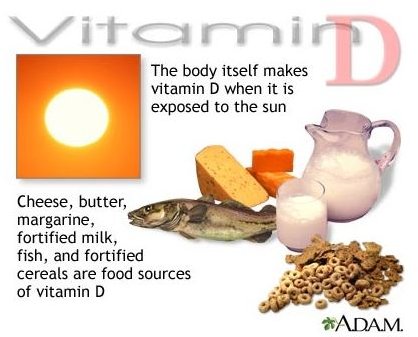Learn about Vitamin D Deficiency Symptoms
Vitamin D
Some have questioned whether vitamin D should be classified as a vitamin because people don’t have to necessarily consume it. The body can make it from cholesterol when the sun shines on the skin. However, because many people don’t get sufficient amounts of sunlight, vitamin D deficiency symptoms can be prevented by eating foods rich in it. Therefore, it remains classified as a fat-soluble vitamin.
Vitamin D is also unique by being the only vitamin to behave like a hormone (relaying chemical messages) in the body.
Vitamin D Deficiency
People with dark skin are at a higher risk of vitamin D deficiency because it is believed that the more melanin (pigment that gives color) in the skin, the less sunlight the skin is able to absorb to make sufficient amounts. People with dark skin need about 5-10 times more exposure of sunlight than people with light skin. Depending on location and age, those with light skin require about 10-15 minutes of sun exposure (without using a sunscreen) on their face and arms a few times a week.
The sun’s ultraviolet rays that produce vitamin D are filtered out by clouds, smog, smoke, clothing, and even some windows.
People who are obese or have a medical problem, such as with the kidneys or digestive tract, are also at risk of becoming deficient in vitamin D.
Symptoms of Vitamin D Deficiency
One of vitamin D’s many roles is to maintain proper levels of calcium and phosphorus in the blood; therefore, an obvious symptom of a deficiency is abnormality of the bones.
Symptoms include:
- growth retardation
- bone deformities
- soft bones
- bone pain
- frequent bone fractures
Rickets, the childhood deficiency of vitamin D, was once a tragic disease. In the 1700s, it was known that cod liver oil was able to cure it but it wasn’t until the turn of the 20th century that it was known vitamin D (in the cod liver oil) was responsible in reversing the condition. Symptoms of rickets include bowed legs, knock-knees, and pigeon breasts.
In adults, the comparable deficiency disease is osteomalacia, softening of the bones caused by calcium being withdrawn from the bones. Bones become porous, weak, and easy to break. This can also affect tiny bones in the ear (responsible for transmitting sounds to the brain) which can lead to deafness.
Besides helping bones, vitamin D is also believed to play a role in developing the brain, maintaining a healthy immune system, reducing inflammation, preventing and treating certain cancers, and preventing many chronic diseases including heart disease and type II diabetes.
Foods Rich in Vitamin D
Foods naturally rich in vitamin D include salmon (4 ounces equals about 103% of the daily recommended value) and shrimp (4 ounces equals about 41%). Cod, mackerel, tuna, liver, and egg yolk are other foods that contain vitamin D naturally.
Fortified foods include milk and other dairy products, grain products like cereals, and juices.
Supplements
Vitamin D supplements are available but caution should be taken when taking them, especially if you have a health problem. Symptoms of toxicity include headache, diarrhea, and nausea. Extreme amounts can be fatal.
Toxicity is normally not a result from diet or too much sun exposure (of course, you do not want too much sun exposure because of other health problems).
Recommended Intake
To prevent vitamin D deficiency symptoms (and toxicity), the following daily amounts are recommended:
- infants, children, adults up to the age of 50, pregnant women, and lactating women - 5 micrograms (200 IU)
- adults 51-70 years old - 10 micrograms (400 IU)
- adults 71 and above - 15 micrograms (600 IU)
Sources Used
WebMD: Are You Getting Enough Vitamin D? - https://www.webmd.com/food-recipes/features/are-you-getting-enough-vitamin-d
WHFoods: Vitamin D - https://www.whfoods.com/genpage.php?tname=nutrient&dbid=110
Photo Credit
Image courtesy of the National Library of Medicine (NLM)
